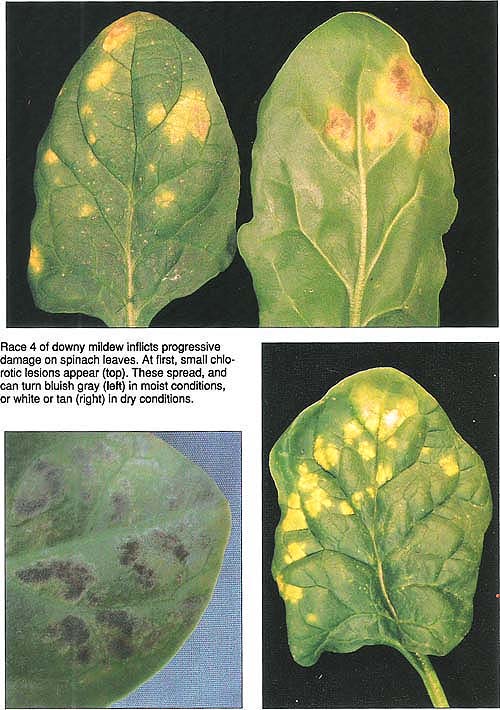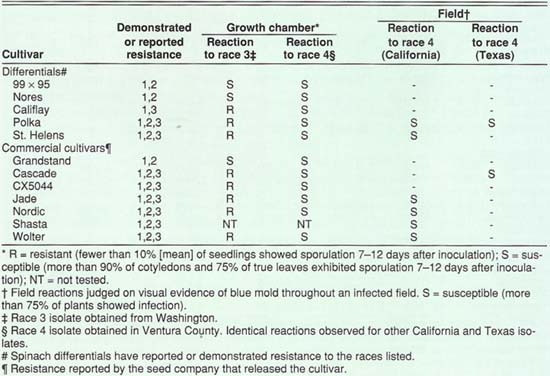All Issues
A new race of downy mildew threatens spinach
Publication Information
California Agriculture 44(6):14-15.
Published November 01, 1990
PDF | Citation | Permissions
Abstract
A new race of downy mildew is threatening spinach in several California and Texas growing areas. Two fungicides, metalaxyl and Aliett, may help control the disease.
Full text
Race 4 of downy mildew inflicts progressive damage on spinach leaves. At first, small chlorotic lesions appear (top). These spread, and can turn bluish gray (left) in moist conditions, or white or tan (right) in dry conditions.
Downy mildew, or blue mold of spinach, caused by the fungal pathogen Peronospora farinosa f. sp. spinatiae (= Peronospora effusa), was observed on several spinach cultivars in the spring, summer, and fall of 1989 in California. Field observations in January 1990 revealed downy mildew in many spinach fields near Oxnard, Ventura County. The disease was also observed near Santa Maria in Santa Barbara County and King City in Monterey County, California, and near Winter Garden, Texas. In the spring of 1990, downy mildew was observed at several locations in the San Joaquin Valley (Stanislaus and Tulare counties).
Initial symptoms appear as diffuse, yellow-green chlorotic lesions that are about 1/4 inch in diameter. These lesions can expand, turn bright yellow, and cover a large portion of each infected leaf. Under favorable conditions, sporulation of the pathogen can be observed on the underside of infected leaves. Dense sporulation is bluish gray, hence the common name “blue mold.”
Under dry conditions, lesions may “bleach out,” turning white or tan. Spores of the pathogen can be airborne, but are relatively short-lived. In general, factors that favor blue mold epidemics are cool temperatures (55° to 70°F) and wet conditions (rain, sprinkler irrigation, or dew). Under these conditions, the pathogen has a short latent period between infection and sporulation (6 to 8 days). Epidemics can progress very rapidly under the right conditions.
Method
We used various spinach cultivars with demonstrated resistance to either races 1 and 2, 1 and 3, or 1, 2, and 3 as differentials for race identification (table 1). The occurrence of downy mildew on cultivars with reported resistance to races 1, 2, and 3 strongly suggested the presence of a new race of downy mildew in California and Texas.
We studied several downy mildew isolates from California and one from Texas in controlled growth chamber inoculations of differential spinach cultivars and commercial cultivars. Another isolate, this one from Washington (race 3), was studied in parallel inoculation tests on the same spinach cultivars. The inoculation tests were conducted at the University of Arkansas.
The inoculations were performed, with only minor alterations, according to previously published procedures. Briefly, we inoculated spinach seedlings when the first two true leaves were about 1/2 inch long (2- to 3-week-old plants). Each seedling was inoculated twice with a conidial suspension containing 2 to 3 × 105 spores per milliliter; the second inoculation was made 12 hours after the first.
We put the inoculated seedlings in a dew chamber and incubated them in the dark at 58°F for 36 to 48 hours after the first inoculation. A thin layer of water was maintained on all leaves during the dew chamber incubation period. Plants were then moved to a growth chamber with a 12 hour light, 12 hour dark cycle, and maintained at 58° to 68°F for 5 to 7 days.
Plants were then moved back into the dew chamber and were incubated at 58°F in the dark for about 24 hours to induce sporulation. Then we checked the cotyledons and the first two true leaves of all seedlings, looking for the presence or absence of sporulation.
TABLE 1. Field and growth chamber reactions of several spinach cultivars to both race 3 and the new physiological race 4 of Peronospora farinosa f. sp. spinaciae
Results and discussion
Our results indicate that a new race of downy mildew, race 4, is occurring on spinach in California and Texas. All cultivars tested were susceptible to race 4, including cultivars resistant to races 1, 2, and 3.
Many fields near Ventura and Santa Maria have been lost to this new race. Race 4 has now been found in all major spinach growing areas of California. In Texas, race 4 has only been identified from a single location. It has not been found in Arkansas or Oklahoma.
Although the origin of race 4 is not known, a new “strain” or race of blue mold has been reported in Japan; this and the U.S. strain may be one and the same. All commercial spinach cultivars tested to date are susceptible to race 4.
Our growth chamber tests indicate that the new race is sensitive to the fungicide metalaxyl. Field tests are currently underway to determine whether this fungicide or some other fungicides could provide effective control.
Prolonged use of metalaxyl may lead to the development of metalaxyl-resistant strains. Such strains would be particularly damaging because of the recent withdrawal of the EBDC fungicides (maneb and mancozeb) and the lack of other materials registered for use on spinach.
Fosetyl-Al (Aliett) recently received emergency registration for use on spinach in California under a Section 18 registration. Contact your county Farm Advisor for information on its proper use.
This disease will most likely continue as a major problem on spinach until acceptable resistant cultivars of spinach become available. Spinach is grown year-round in some production areas in California, so there will probably be a continual source of downy mildew inoculum to initiate epidemics. Furthermore, several weed species, including nettleleaf goosefoot (Chenopodium murale), have been observed to be infected with a Peronospora sp. in commercial spinach fields. We do not know whether weeds can serve as hosts for carryover inoculum.






